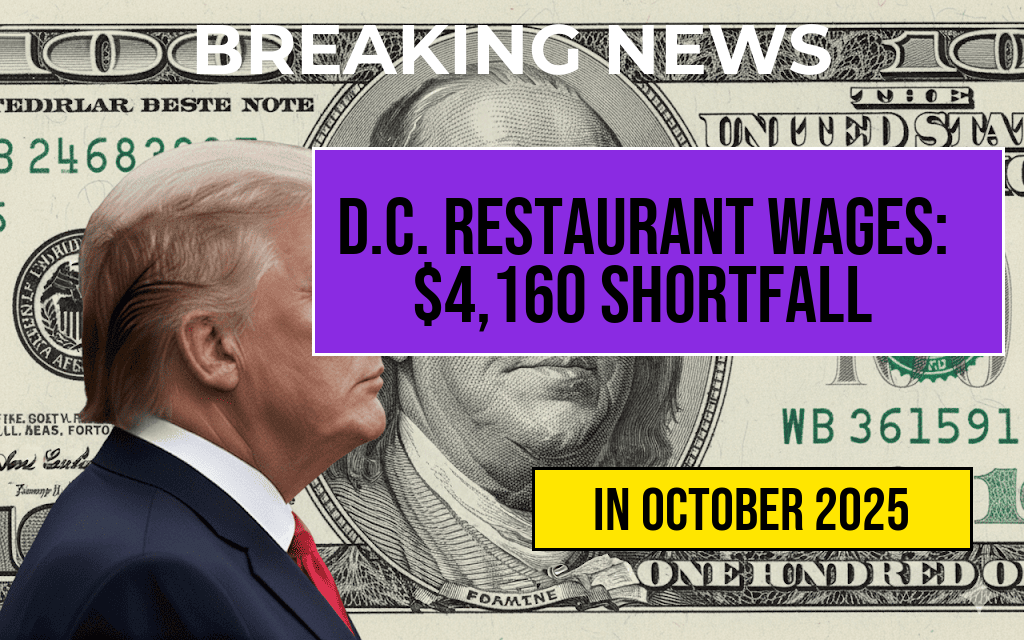Washington D.C. Maintains $10 Minimum Wage for Restaurant Workers, Sparking Debate Over Economic Impact
Washington D.C. has upheld its minimum wage for restaurant employees at $10 per hour, despite ongoing discussions about raising it to a level that better reflects living costs in the region. This decision results in an annual shortfall of approximately $4,160 compared to a $12 hourly rate—an amount that many advocates argue could significantly improve workers’ standards of living. While supporters emphasize the importance of keeping operating costs manageable for small businesses, critics warn that stagnant wages threaten to exacerbate economic disparities and hinder workforce stability in the hospitality sector.
With the current minimum wage unchanged since 2019, restaurant workers in D.C. earn less than the city’s estimated living wage, which various studies peg at around $15 to $17 per hour for a single adult. This gap translates into lower annual earnings, especially for those working full-time, fueling ongoing debates about wage fairness, economic sustainability, and the future of restaurant employment in the district.
The Numbers Behind the Shortfall
| Wage Rate | Weekly Hours | Weekly Earnings | Annual Earnings (52 weeks) |
|---|---|---|---|
| $10/hr | 40 | $400 | $20,800 |
| $12/hr | 40 | $480 | $24,960 |
| Difference in Annual Earnings: $4,160 | |||
This $4,160 disparity underscores the financial gap many restaurant workers face annually, which could be mitigated by increasing the base wage to $12 per hour—a move supported by several labor advocacy groups and economic analysts who argue it aligns more closely with regional living expenses.
Economic and Political Context
The decision to keep the minimum wage at $10 was made amidst a backdrop of political negotiations and economic considerations. District policymakers express concern over the potential impact on small restaurants, arguing that a sudden wage increase could lead to higher prices or reduced employment. Minimum wage laws across the country have historically balanced worker protections with economic growth, but the debate remains heated in D.C., where the cost of living ranks among the highest in the nation.
Supporters of raising the wage point to studies indicating that higher wages can lead to increased employee retention, improved customer service, and greater economic activity. According to a report by the Forbes, higher earnings can also reduce reliance on public assistance programs, easing financial strain on local government resources.
Impact on Restaurant Industry and Workers
Many restaurant workers in D.C. rely heavily on tips, which can sometimes elevate actual earnings above the base wage. However, the variability of tips makes stable income elusive, especially during slow seasons or economic downturns. For tipped workers, the federal minimum tip credit in D.C. allows employers to pay less than the standard minimum wage, provided tips make up the difference to reach at least $10 per hour.
Restaurant owners express concern that mandated wage increases could lead to higher menu prices, reduced staffing, or even closures. Conversely, workers and labor advocates argue that fair wages are essential for attracting and retaining qualified staff, particularly in a competitive labor market driven by a high cost of living.
Comparative Wage Policies in the Region
Neighboring jurisdictions have taken different approaches to restaurant wages. For instance, Montgomery County, Maryland, increased its minimum wage to $12.50 in 2023, with plans to rise further. Virginia, which has a statewide minimum wage of $12 per hour as of 2023, also influences the regional dynamic. These policies reflect broader trends toward higher minimum wages in urban centers, aiming to address economic inequality.
Looking Ahead: Possible Changes and Implications
As discussions continue, several advocacy groups are pushing for incremental increases to reach a $12 or higher minimum wage within the next few years. Such changes could help close the earnings gap and improve quality of life for restaurant workers, many of whom are among the city’s essential workers.
Meanwhile, restaurant associations remain cautious. They emphasize the need for balanced policies that support both workers and the broader economic health of the industry. Policymakers in D.C. are expected to revisit the wage issue during upcoming budget sessions, weighing economic data, industry input, and worker advocacy efforts.
Ultimately, the debate over D.C.’s restaurant wages encapsulates larger questions about economic equity, affordability, and the future of urban employment policies. As the city navigates these challenges, the decisions made will likely influence regional labor standards and set a precedent for other jurisdictions grappling with similar issues.
Frequently Asked Questions
What is the current minimum wage for restaurant workers in D.C.?
The current minimum wage for restaurant workers in D.C. is set at $10 per hour.
How does the $10 hourly rate impact annual earnings for restaurant employees?
At a $10 hourly rate, restaurant employees face an annual shortfall of $4,160 compared to earning a $12 hourly rate, which would be more equitable.
Why is there a debate over increasing the restaurant minimum wage in D.C.?
The debate centers on fair wages for restaurant workers, with proponents arguing for an increase to improve living standards, while opponents cite business concerns about higher labor costs.
What would be the financial difference if D.C. raised the minimum wage to $12 an hour?
If D.C. increased the minimum wage to $12/hour, restaurant workers would earn an additional $4,160 annually, reducing the current shortfall and supporting better economic stability.
Are there any proposals or movements advocating for raising the minimum wage in D.C.?
Yes, local advocacy groups and labor organizations are pushing for a raise in the minimum wage to ensure fair compensation for restaurant workers and address existing wage disparities.

Leave a Reply